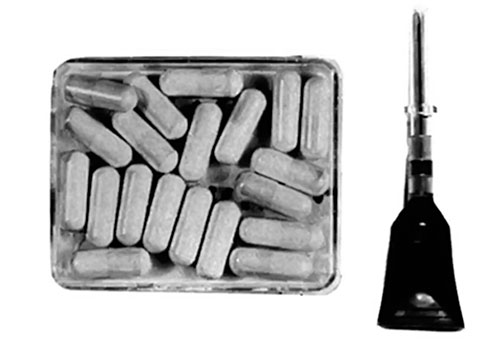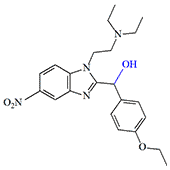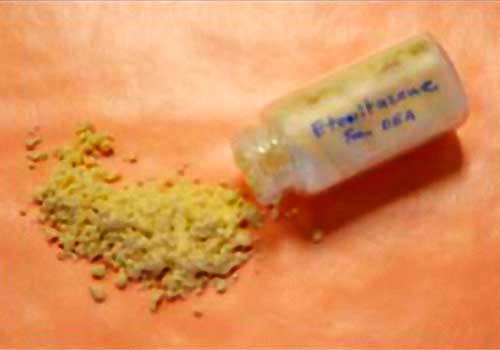Etonitazene (CS 4640)


Senator Barry Goldwater considers the M-1 electric pistol for firing tranquilizing or lethal needle bullets (U.S. Senate hearings, 1975)
Etonitazene is an opioid analgesic from the group of 5-nitrobenzimidazole derivatives, a selective μ1-receptor agonist[9]. Etonitazene was synthesized in 1957 by chemists from the Swiss pharmaceutical company CIBA[7].

Etonitazene
EA 4941, CS 4640, Ba-20684, Ciba 20-684BA, NIH-7607, ARC I-G-2.
The first experiments showed that the new drug was at least 1500–1700 times more potent than morphine in mice and rats it is also 1500 times as potent as morphine in suppressing the morphine abstinence syndrome in the monkey. Experiments on humans, a little disappointed the researchers — etonitazene was not as powerful as expected, analgesia and euphoria similar to morphine occurred when taking orally or subcutaneous injection of 0.25 mg of the drug. In fact, etonitazene was not 1000 times stronger than morphine, but "only" 60–100 times stronger[25].
Etonitazen and Intelligence
The CIA and the U.S. Department of Defense, closely following the emergence of new chemicals with high biological activity, were able to quickly obtain samples of etonitazene. Harris Isbell from the National Institute of Mental Health was engaged in its study at the CIA. In 1954–1964, Isbell was engaged by the CIA to work on the MKPILOT project, which was part of the more extensive MK-Ultra program, including the search for substances causing rapid addiction, knockout, increasing suggestibility and similar. The experiments were conducted on drug addicts at a rehabilitation center in Lexington, Kentucky, under the guise of a national program to find new pain medications. All data on human trials of 800 drugs, including the recently discovered etonitazene, were promptly transmitted to the CIA[27].

Etonitazene capsules to neutralize
dogs and syringe-tube with antidote
The rapidity and high activity of etonitazene, so necessary for CIA field operatives to immobilize the enemy, did not interest pharmacists, for them the main factor was the safety of the drug for the patient. Even a small overdose of etonitazene caused respiratory depression, and prolonged use led to narcotic dependence.
Eventually, the CIA also decided that etonitazene was too dangerous to use against humans, although they continued to use it to neutralize guard dogs during special operations. Initially, this was done by using ordinary capsules of etonitazene, which were added to the dog's food. To avoid suspicion of a sleeping dog, the capsules came with an antidote, which allowed the animal to be quickly revived after the operation.
Later, in the 1960s, the CIA, in cooperation with Army specialists, developed a special cartridge for the standard 7.62 mm cartridge designed to fire needle bullets, or "micromissiles" as they were called. The M-1 micromissiles were one of five biological sabotage weapons, also known as the "Big Five," developed by the Special Operations Division (SOD). Made of steel and platinum, this "micromissile" had a diameter of 0.25 mm and a length of 25 mm, and its tip was coated with gelatin containing 3 mg of etonitazene[18]. This amount was enough to put a dog to sleep for 4–6 hours, but for a human such a dose could be fatal. At least four modifications of such "micromissiles" were produced for the U.S. Army, including for the M-1 rifle and M209 pistol, in which etonitazene was replaced by lethal poisons such as, for example, botulinum toxin (XR), saxitoxin (TZ), or a combination thereof[11].
  Senators Frank Church and John Tower demonstrate a poison dart gun (U.S. Senate hearings, 1975) |
  Needle sub-caliber ammunition for the standard .30–06 Springfield cartridge |
Later, a more advanced model of such a weapon was developed — the electric pistol E-1/M-1, it was virtually silent, and the Javettes needle bullets fired from it quickly and painlessly dissolved into the human body, leaving no trace. The poison or anesthetic acted quickly, and even if a person felt the injection, he still did not have time to remove the needle from the body[17].
Etonitazene as Incapacitant
The U.S. Chemical Corps was initially enthusiastic about the new incapacitant. Numerous experiments were conducted on the effects of etonitazene on mice, rats, guinea pigs, rabbits, cats, dogs, goats and monkeys.
In 1959, a demonstration of the effects of an aerosol of 0.1% etonitazene solution was performed on two dogs for members of a U.S. congressional committee overseeing the development of chemical and biological weapons. After half a minute the animals became relaxed and after one minute they were completely immobilized. After 10 minutes, one of the dogs was administered an antidote, after which the animal became completely normal within a few minutes. The second dog, which had not received the antidote, also fully recovered after an hour's sleep.
However, a brief burst of hope of quickly obtaining an effective and safe incapacitant was followed by disappointment — further experiments found that, safe for rodents, etonitazene proved too toxic for primates. Despite this, the Edgewood Arsenal continued attempts to create a chemical agent based on the structure of etonitazene that was equally active but less dangerous to humans. In experiments to determine the lethal dose for etonitazene, so many monkeys were killed that it caused protests from the International Primate Protection League (IPPL)[20].
Most benzimidazole derivatives synthesized in the mid-'60s US Army Chemical Research and Development Laboratories, in cooperation with Research Triangle Institute[2] were significantly inferior to etonitazene — the slightest change in structure resulted in a drop in activity, and only a few left some hope. At least three groups of etonitazene derivatives were investigated as potential incapacitants, in which the methylene bridge –CH2– was replaced by a group
 |
 |
 |
| EA 5270 | EA 2664 | 5-nitro derivative "Soviet Nitazene" |
Synthesized in 1961 in West Germany, the etonitazene derivative with a hydroxyl group in the –CH– bridge was five times more potent and 125 times safer[4,5]. This substance was assigned code EA 5270 at Edgewood Arsenal. It was hypothesized that one of its isomers might have been a more preferable incapacitant than etonitazene[3].
| Etonitazene | EA 5270 | |
| Analgesic dose (AD50) mouse, subcutaneously | 0.005 mg/kg | 0.001 mg/kg |
| Median lethal dose (LD50) mouse, intravenously | 1 mg/kg | 25 mg/kg |
| Therapeutic index (LD50/AD50) | 200 | 25 000 |
The drug under the code EA 2664, like etonitazene, was first synthesized in the Swiss company CIBA in 1958[13]. It is comparable to etonitazene in activity but proved to be more toxic[3].
The formula of another incapacitant from the benzimdazole group is given in a Soviet textbook on military toxicology, without reference to the source. The authors of the textbook state that this drug has an immobilizing effect at a dose of 0.001 mg/kg and that its "toxodose is three orders of magnitude higher than the incapacitating one"[6].
According to Swiss pharmacologists, a compound with this structure is only ten times more potent than morphine, so there must be a mistake in the formula — NO2 radical is absent. Its 5-nitro derivative is 200 times more potent than morphine[7]. Upon further investigation, it has been found that one of the isomers of the 5-nitro derivative of "Soviet Nitazene" is six times more potent than etonitazene, with the same level of toxicity (This information needs clarification)[26].

The incapacitant formula from the Soviet textbook "Chemical Warfare Agents" (Aleksandrov V. & Emelyanov V., 1990)
Etonitazene derivatives are not of interest as chemical weapons — as lethal chemical agents, they are inferior to nerve agents and fentanyl derivatives by all parameters, and for incapacitants, they are too toxic.
The Abuse of Etonitazene
Etonitazene overdoses first reported in Germany in 1997 and in Russia in 1998. The drug, also known as "white dwarf," quickly gained notoriety for its deadly effects and caused the deaths of 18 people in just a few months. In 1998, the first clandestine laboratory for the production of etonitazene dismantled in Moscow. This drug is very potent. Smoking a cigarette infused with a small amount of etonitazene on a cotton thread was enough to get a "dose." The ash of such a cigarette remained active — even when smoked again, it relieved withdrawal in drug addicts[1].
In 2003, Thomas Highsmith, an underground chemist, synthesized etonitazene for personal use in the form of a nasal spray. After a few months of constant intake, he required a daily dose of 300 times the initial dose. The strange behavior of an employee who would not part with a bottle of nasal spray for a single minute led his colleagues to contact the police. Since the suspect was not in the business of selling the drug, police did not arrest him pending a court order. However, Thomas Highsmith could not withstand the severe withdrawal and committed suicide without waiting for his sentence[10].

Ethonitazene synthesized by Thomas Highsmith
Foto: Microgram Bulletin, №12, 2003
In 2019, Isotonitazene, an O-isopropyl homolog of Etonitazene, emerged on the designer drug market in the United States, Canada, Belgium, and Australia. Isotonitazene is four times stronger analgesic than fentanyl in animal experiments[15].
In 2021, the N-pyrrolidine analog of etonitazepyne, Etonitazepyne, caused eight fatal overdoses in the United States. According to the Center for Forensic Science Research and Education (CFSRE), the results of in vitro experiments suggest that Etonitazepyne is a 20 times more potent analgesic than fentanyl[19]. Few reports on specialized forums confirm the high risk of taking this drug — a case of loss of consciousness and respiratory arrest after intranasal administration of only 1 mg of Etonitazepyne has been described.[21]. In people with a high tolerance to opioids, initial effects occur after as little as 0.15 mg[21]. This opioid has a long-lasting effect that can last for up to 24 hours[23] and rapid addiction — after using it regularly for a month, the doses can increase to tens of milligrams[24].

Isotonitazene |

Etonitazepyne |
In general, nitazene opioids have proven to be even more dangerous than fentanyl derivatives, not only because of their high toxicity but also because of the minimal difference between the euphoria-inducing dose and the dose that leads to death by suffocation. Many of them produce a very weak euphoria, and attempts to enhance it by increasing or repeating the dose can end tragically.